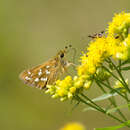Biology
provided by Arkive
The flight period occurs between late July and early September. This species is single-brooded; eggs are laid singly on the leaves of sheep's-fescue growing in a short sward next to patches of bare soil. The eggs remain un-hatched through winter; larvae emerge in early spring and feed beneath small protective webs. Pupation occurs in a cocoon at ground level (3).
Conservation
provided by Arkive
Targeted conservation work continues on a number of nature reserves and Sites of Special Scientific Interest (SSSIs). Agri-environment schemes such as Countryside Stewardship and Environmentally Sensitive Areas, include measures to encourage farmers to manage their land in ways that benefit this species (3). An increase in stock grazing, preferably by cattle, in important sites will decrease this skipper's dependency on rabbit grazing, which is often unpredictable (3).
Conservation of the silver-spotted skipper requires a landscape-scale approach, as the species persists in 'metapopulations', occupying discrete habitat patches connected by dispersal over quite large areas (3). A number of reintroductions to nature reserves in Kent have been attempted, as natural recolonisation was unlikely (3). The silver-spotted skipper is a priority species under the UK Biodiversity Action Plan (UK BAP) (4).
Description
provided by Arkive
This butterfly is orange-brown in colour with pale spots that are more noticeable on females. The underside is pale brown with silvery spots, and males have a black band on the upperside of the forewing (1). The caterpillar reaches 2.6 centimetres in length, and has a dull olive-green body with a black collar behind the large black head (2).
Habitat
provided by Arkive
Breeds on warm, south facing slopes in open chalk grassland with short turf and patches of bare soil. The presence of the larval foodplant, sheep's-fescue (Festuca ovina), is essential (3).
Range
provided by Arkive
The rare silver-spotted skipper is found across Europe and throughout temperate Asia. In Britain it is restricted to chalk downland in southern England following a substantial decline which resulted in its extinction in Yorkshire, the Cotswolds, the northern parts of the Chilterns and much of the North Downs (3).
Status
provided by Arkive
Protected in Great Britain by the Wildlife and Countryside Act 1981, with respect to sale only (4).
Threats
provided by Arkive
Habitat loss and fragmentation has been a key factor in the decline (4). Agricultural intensification has removed much habitat, but neglect and a decline in grazing results in the sward growing too high for the species. Grazing by rabbits decreased the effect of abandonment, but myxomatosis caused a crash in rabbit populations in the early 1950s. The silver-spotted skipper went into rapid decline as a result of the decrease in grazing (3). A combination of the recovery of rabbit populations and targeted conservation work resulted in a partial recovery of this butterfly in the 1980s and 1990s (3).

